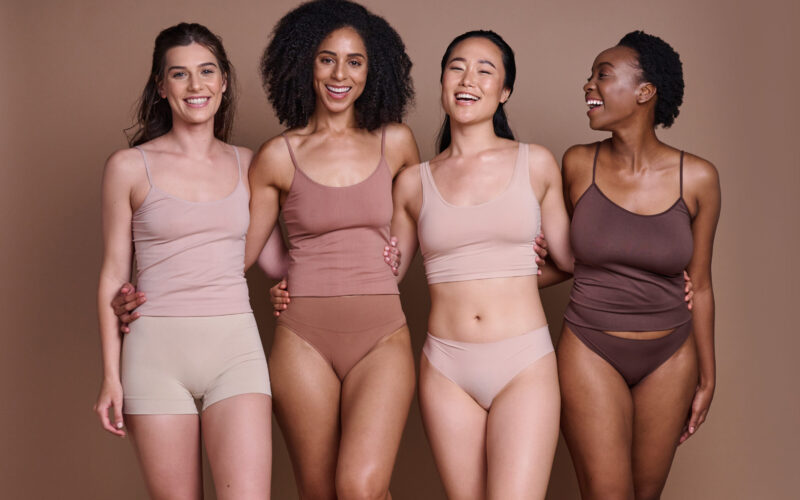Underwear. Something we all (well… most people) wear, something people hardly talk about, and something women tend to be very passionate about when it comes to personal style. Every woman’s body is different, so it makes sense that every woman would have a different underwear preference based on her body. But is there a better (or worse) underwear for your health “down there?”
Does style matter?
From thongs to full coverage, there are many different underwear styles out there. Let’s focus on some of the most popular styles to see if style might impact santé vaginale (and investigate some rumors about one particular style!).
Briefs
Also lovingly referred to as “granny panties,” these are full coverage and often higher-rise underpants that provide support and reduce friction on the vulvar area. These are often fully cotton underwear, making them both breathable and comfortable, but also prone to showing panty lines if you’re wearing tight-fitting clothing.
Boyshorts/Hipsters
Inspired by men’s boxers, boyshorts are another modest and full coverage style like briefs. The “shorts” can minimize chafing compared to other styles of underwear, particularly briefs or bikinis. Unlike many briefs, these tend to be low-rise and don’t ride up like some other styles can. However, boyshorts are also commonly found in non-cotton fabrics, which may trap in moisture, leading to vaginal health issues.
Bikinis
With more moderate coverage, these are one of the most popular styles. Compared to more restrictive styles, the bikini style offers more breathability, which can lead to better vaginal health. Caution is needed in ensuring proper fit for this style; bikini underwear that’s too tight can lead to uncomfortable panty lines or chafing around the groin.
Thongs
Perhaps the most controversial of all underwear styles, thongs are thought to be the bane of vaginal health…but that’s not actually true. While perfect for avoiding panty lines, finding the right fit is important as thongs are not actually supposé to give you a wedgie.
Perhaps the most controversial of all underwear styles, thongs are thought to be the bane of vaginal health… but that’s not actually true.
While the common understanding of thongs is that they may promote infection by moving between the anus (where bacteria like E. coli is found) and the vagina or urethra (bringing bacteria with it), studies have found that might not actually be the case.
One such étude publié dans le Journal of Obstetrics and Gynecology Research surveyed 986 women and found that 186 were regular thong wearers (wearing thongs over 50% of the time). Rates of infections in both urinary organs and vaginas over the past 12 months were similar in both the thong and non-thong wearers, which led to the conclusion that thongs did pas increase risk of urogenital infections like previously thought [1]. In fact, the only predictor of urinary tract infections et vaginose bactérienne found in the study was oral sex, while the only predictor of infections à levures was wearing underwear that didn’t have a cotton crotch [1].
Autre étude published in 2005 in Medical Journal Sweden wanted to compare the differences between thongs (and thong-shaped panty liners) and non-thong underwear (plus normal shaped panty liners) on the vulvar skin environment. Thirty two women were tested in both types of underwear with their respective panty liners, and the results were not statistically significant in either direction. Furthermore, “no support was found for the assumption that a string panty system would result in higher contamination of vulvar skin by anorectal microflora” [2].
Still, if you’re prone to rashes, skin inflammation, or hemorrhoids, wearing thongs regularly might not be the best for you–the rubbing that comes with wearing a thong may “create small cuts between the anus and vagina, causing irritation to the skin” according to a Health Digest interview with OB-GYN Dr Mary Jane Minkin.
Fabric over fashion
When it comes to vaginal health and underwear, it seems that fabric is more important than style. Here are the factors OB-GYNs told one underwear company were the most important for vaginal health:
- Breathable fabrics: the biggest factor in promoting a healthy vaginal environment is finding breathable fabrics to reduce trapped moisture
- Size and fit: finding the right size underwear can protect your skin from chafing and allow for good airflow
- Moisture control: fabrics that wick away moisture, especially when exercising or in hot and humid environments, is crucial for maintaining a sweat-free environment, a properly balanced vaginal pH, and preventing overgrowth of harmful bacteria
- Avoiding irritants: Fragrances, dyes, and chemicals in fabric can lead to irritations and even allergic reactions
When it comes to vaginal health and underwear, it seems that fabric is more important than style.
Cotton
Lauded as the holy grail of underwear fabrics, cotton is breathable, absorbs moisture and is naturally hypoallergenic (with fewer dyes and chemicals compared to other fabrics). However, cotton doesn’t dry quickly, making it less ideal when exercising or being in a hot or humid environment.
Plant-Based Fabrics
Like rayon, modal, and bamboo, these types of underwear have similar breathability to cotton while having better moisture-wicking ability. However, these are treated with more chemicals than cotton, so they’re not technically “natural” fabrics.
Performance/Synthetic Fibers
Moisture wicking and quick to dry, fabrics like polyester and nylon are ideal for underwear for working out, as long as you remove them soon after. However, for day-to-day wear, these are significantly less breathable than either cotton or plant-based fabrics, and can trap in heat and moisture and make a bacterial breeding ground.
In fact, one 2012 étude in Nigeria found that out of 176 women between the ages of 20 and 35 years old, women who wore tight nylon/synthetic underwear had a 4.8 times higher likelihood of developing Candida albicans, the most common fungus found in yeast infections, compared to women not wearing underwear from synthetic fibers [3].
Moisture-Wicking Blends
Blends of natural and synthetic fibers aim to be the best of both worlds and are becoming more common. Less breathable than cotton but better moisture control than performance fibers, these are good for occasional use or during exercise, but if you choose these, make sure they have a cotton gusset.
The secrets to healthy underwear habits?
Use underwear with good quality cotton gussets
The secret superhero when it comes to underwear is the cotton gusset–that little pocket of material in the crotch of your underpants. Serving as a protective barrier between the delicate vulvar skin and clothing, reducing friction, and helping air circulation, cotton gussets not only provide a layer of protection from the outside clothing, but protection from moisture, odors, and infections.
Making sure the gusset fits well is paramount. If it covers the entire labial area, then it will increase protection from outside irritations as well as prevent odors from sweat and moisture from building up, keeping the skin dry and cool. Gussets that are too small or poorly made can cause bunching, chafing, or may tear off completely, leading to even more vaginal irritation.
Keep your underwear clean
Washing techniques for underpants might seem silly, but the science agrees that your delicates should be given special treatment. According to a étude publiée dans la revue American Society for Microbiology, washing clothes between the temperatures of 104℉ and 140℉ kills bacteria.
Using laundry detergent helps release the bacteria from the fabric along with killing certain types of bacteria sensitive to detergent. If you prefer running your laundry on the cold setting, temperatures below 68℉ require the adding of an enzymatic cleaner to kill germs, especially those viruses and bacteria from the GI tracts (but for the sake of vaginal health, try to avoid adding bleach to any loads with underwear!) [4]. On top of that, using fragrance-free detergents, fabric softeners, and avoiding harsh chemicals will help to avoid skin irritation and maintain a healthy vaginal pH.
Change underwear frequently
OBGYN Dr. Erica Newlin explained to the Clinique de Cleveland that one of the most simple yet important things you can do to maintain vaginal health is to change your underwear at least daily. This can prevent odors, yeast infections, and bacterial growth.
If you are sweating and your underwear becomes wet, changing your underwear more frequently is a good idea. If you are annoyed by a buildup of vaginal discharge (like that from glaire cervicale), opt for changing your underwear rather than using a panty liner. This leads to my next point…
Avoid habitual panty liners
As we’ve mentioned many times already, creating a breathable environment with good air flow is crucial for maintaining a healthy vaginal biome. Panty liners, while great for use on your period or for incontinence, are not meant for everyday use and can be a breeding ground for bacteria.
As we’ve mentioned many times already, creating a breathable environment with good air flow is crucial for maintaining a healthy vaginal biome. Panty liners are not meant for everyday use and can be a breeding ground for bacteria.
Vaginal health needs throughout life
Clearly, there are a lot of factors when it comes to finding the best underwear for your vaginal health, but there are several populations that should take extra consideration when deciding what to wear down there.
Adolescents
When going through puberty, hormones can cause excess sweating all over the body, including around the groin. Maintaining good body hygiene practices along with good underwear hygiene is key to avoiding odors, irritation, excess moisture, and infections. Aim for breathable cotton fabrics (or moisture wicking material if you’re particularly sweaty as long as it gets changed out as frequently as needed) and avoid tight fitting panties.
Pregnant and postpartum women
Higher rise panties may provide more support for pregnant mothers, though some women may find the additional fabric on their growing belly annoying. However, with weakened abdominal muscles post-partum, high rise underpants can provide a feeling of security and support (not to mention they’ll have enough room to accommodate that mattress of a postpartum pad… IYKYK). Once again, aim for breathable materials like cotton, and change underwear as frequently as needed postpartum to promote healing and avoid infection if you had a perineal tear during labor.
It may be a good idea to set aside a small underwear budget to accommodate your changing body shape with properly fitting underwear, both in pregnancy and postpartum.
Ménopause
Hormone changes and hot flashes lead to lots and lots of sweat. Moisture wicking fabrics may provide the most comfort, while lightweight and breathable options can also help regulate body temperature, helping you to stay cool.
The big picture
Ultimately, what you wear is a choice best left to vous, however, all women should know what is best for their vaginal health. I recommend this great resource from the University of Iowa: a very handy guideline to all things vulvar health, from laundry products, to bathing, period products; it covers it all. And if you’re into quizzes, one underwear brand put together a fun webpage on how to choose the right underwear for your body shape, butt shape, and lifestyle, along with other helpful tips.
Whether you’re a thong girly, a gym regular who needs performance fabrics, or a granny-panties-for-life kind of gal, remember that not all underwear is created equally, and getting the right type of underwear could change your vaginal health in a way that you never considered!
Références
- Hamlin, A.A., Sheeder, J. and Muffly, T.M. (2019), Brief versus Thong Hygiene in Obstetrics and Gynecology (B-THONG): A survey study. J. Obstet. Gynaecol. Res., 45: 1190-1196. https://doi.org/10.1111/jog.13958
- Runeman, B., Rybo, G., Forsgren-Brusk, U., Larkö, O., Larsson, P., & Faergemann, J. (2005). The vulvar skin microenvironment: impact of tight-fitting underwear on microclimate, pH and microflora. Acta dermato-venereologica, 85(2), 118–122. https://doi.org/10.1080/00015550410024562
- Ekpenyong CE, Inyang-etoh EC, Ettebong EO, Akpan UP, Ibu JO, Daniel NE. Recurrent vulvovaginal candidosis among young women in south eastern Nigeria: the role of lifestyle and health-care practices. International Journal of STD & AIDS. 2012;23(10):704-709. doi:10.1258/ijsa.2012.011382
- Abney, S. E., Ijaz, M. K., McKinney, J., & Gerba, C. P. (2021). Laundry Hygiene and Odor Control: State of the Science. Applied and environmental microbiology, 87(14), e0300220. https://doi.org/10.1128/AEM.03002-20







